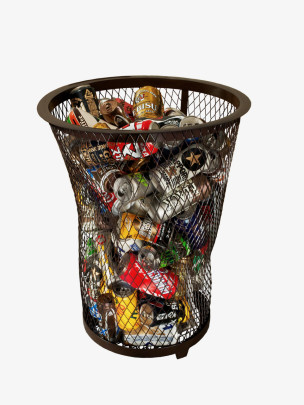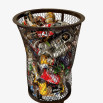三島喜美代 MISHIMA Kimiyo 1932–2024
- Work 12-C2 2012年 印刷したセラミックに手彩色、鉄 64x64x74cm 販売済み
Work 12-C2 2012 Printed and painted ceramic, iron 64x64x74cm sold - News Paper Los-s セラミック 20×20×21cm 販売済み
News Paper Los-s Ceramic 20×20×21cm sold
1932年に大阪に生まれた三島喜美代は、1970年代初頭まで絵画に取り組み、主にコラージュによる平面作品で注目を集めました。平面作品では1965年シェル美術賞展佳作賞を受賞。その後、 70年代初頭より陶による作品制作を始めます。陶の作品では、 1971年日本陶芸展前衛部門入選を皮切りに、数々の公募展での入選・受賞、国内外での展覧会に招待出品されるなど、今日に至るまで精力的に活動を続けてきました。
三島の陶の作品は、新聞や雑誌の紙面、商標の印刷された段ボール箱などの活字をシルクスクリーンで転写したものが主体となります。三島は、陶器は割れるという性質を持つことから、不安感や危機感、危うさを表すのに適した媒体だと位置づけます。当初、三島は、情報に埋没する危機感を表現することを試みていました。しかし、大量のビラや新聞、雑誌はすぐに廃棄されてゴミとなるように、情報からゴミへと制作上の問題意識を転換させたことで、捨てられたゴミを手間とお金をかけて陶器で作るという現在の三島の創作スタイルが確立しました。そこでは、かつてとは比較できない今日の社会特有の大量の情報とゴミの関係が、ユーモアをもって示されるとともに、過剰な情報に脅かされて生きる現代人の心理が表象されています。
<京都国立近代美術館「2020年度 第4回コレクション展」ウェブサイトより引用>
Born in Osaka in 1932, Mishima Kimiyo focused on painting until the early 1970s, receiving acclaim for her collage-style two-dimensional works. In 1965, Mishima received the Shell Art Award. Then, in the early ’70s, she turned her attention to ceramics. After first being selected for inclusion in the avant-garde division of the Japan Ceramic Art Exhibition, Mishima’s work was included and awarded prizes in countless open-call exhibitions, and she was invited to take part in domestic and foreign exhibition. Mishima remains tirelessly active to the present day.
The majority of Mishima’s ceramic pieces feature silkscreen transfers of type from the pages of newspapers and magazines, and cardboard boxes bearing trademarks. Due to the breakable quality of the material, Mishima chose ceramics as the most suitable medium to express a sense of unease, anxiety, and crisis. Initially, she set out to convey the danger of being submerged in information. Later, by switching her focus to the way in which information becomes garbage (for example, mass quantities of handbills, newspapers, and magazines are quickly thrown away), Mishima arrived at her present style in which she uses time and money to make ceramic expressions of discarded waste. In this way, the artist takes a humorous approach to this unparalleled relationship between the huge amount of information and garbage, a peculiar facet of present-day society. At the same time, Mishima expresses the mentality of contemporary people, whose lives are threatened by an excess of information.
< from The National Museum of Modern Art, Kyoto - '4th Collection Gallery Exhibition 2020–2021' >






